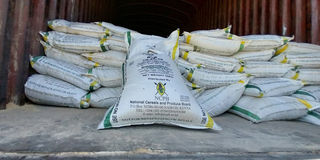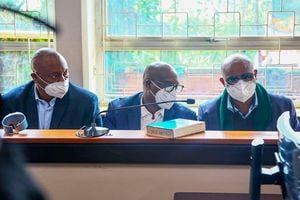
Agriculture Cabinet Secretary Mithika Linturi addresses members of the Senate Select Committee that is considering the motion to impeach him during the hearing at County Hall Nairobi on May 9, 2024.
Agriculture Cabinet Secretary Mithika Linturi is going through a rough patch over the fertiliser saga.
In other untainted democratic jurisdictions, he ought to have quit as a matter of principle.
But we must understand that we live in a hyenas' den where limping is a tradition.
I am just surprised that we are feigning surprise that some people had the audacity to pass soil and sand as fertiliser.

Some of the 560 bags of substandard fertiliser that were seized at the National Cereals and Produce Board depot in Molo, Nakuru County on March 23, 2024.
That is not the first fertiliser scandal – and it will not be the last. Have we forgotten how we continue to pay millions of shillings for a non-existent fertiliser factory?
This project was sabotaged by cartels involved in fertiliser imports during the Jomo Kenyatta regime.
The initial proposal to set up the factory in Bamburi was given to Finance Minister James Gichuru in 1965, and he thought that Kenya would finally solve the soil fertility crisis it was facing.
He also thought it would support the settlement schemes in becoming viable. Then, it seems, the cartels caught wind of the new shift.
Mr Gichuru – and he had a problem with a tipple – was told that the project was not viable, and it was abandoned. A chance to build a fertiliser factory two years after independence was thus shelved.
But after the oil shocks in 1973 and 1974 led to a considerable price increase in the popular petroleum-based fertiliser, the then Minister for Agriculture Jeremiah Nyagah signed a contract with an American company, N-Ren Corporation of Cincinnati, Ohio, to form a local company, Ken-Ren, at Sh480 million and to produce 240,000 tonnes of fertiliser locally.
This factory would later be sabotaged, and we were penalised for that. That is how we let some fertiliser cartels run the sector as we continued to pay penalties.
As Peter Anyang Nyong'o would later say in 1993: “We destroyed Ken-Ren because we wanted to continue getting import licenses. We could today be producing several varieties of fertilisers if Ken-Ren in Mombasa were working.” Kenya has had its share of unbelievable scams.
Some years ago, Parliament was told that the late Kimani Kongo had supplied Nairobi Water with chalk and passed it as chlorine.
He was paid Sh70 million for all his troubles. When I met him later, he denied that claim. I later found that he had delivered some unusable phosphate powder, which remained hidden in Nairobi's industrial yard of Nairobi water.
After the post-election violence, President Mwai Kibaki thought he could introduce fish farming to the Mt Kenya region during his presidency. Farmers were asked to invest in fishponds, and there was a guaranteed market for the tilapia.
The story is that the frogs invaded the ponds and ate all the fingerlings, or the tenderpreneurs supplied farmers with tadpoles.
What is known is that the Sh4.8 billion project collapsed under the weight of that scandal. Nobody talks about it – and nobody was prosecuted. Farmers had spent a fortune, and it turned out that all the pods were full of frogs.
We are also in a country where farmers have lived with the gamble of fake seeds, and farming has become a game of chance.
Ever since Moi allies grabbed Kenya Seed Company, it lost all its “table-manners” and, like a glutton, embarked on swindling farmers. More so, the liberalisation of the seed sector left farmers on their own, and that is how our maize sector collapsed. You cannot expect a bumper harvest based on fake seeds.
The Ministry of Agriculture seems unable to tame that multi-million fake seeds racket. Still within that ministry, we had the saga of rats at the Pyrethrum Board of Kenya.
Who remembers the March 30, 2003 fire that gutted down the pyrethrum processing factory in Nakuru? Kenyans were told that the “likely cause” was an electrical fault – the usual culprit in unexplained infernos in government buildings when someone wants to destroy evidence.
As then Nakuru Town MP Mirugi Kariuki told Parliament, “There was not a single fire fighting equipment at the factory” when the fire broke out. Some officials from the parastatal would later tell a Parliamentary Committee on Agriculture that pyrethrin worth Sh2.4 billion was also “eaten by rats!”. That Nakuru rats could eat pesticide was a new one – but that is how they explained the unaccounted-for pyrethrin.
There was the other racket we all lived with where top officials at Kenya Pipeline would cook figures and allege that millions of fuel were lost through spillage.
They would then force the consumers to compensate the oil marketers by hiking the prices in a scandal that involved KPC and the regulator. Finally, the regulators got tired of the scandal and demanded a forensic investigation.
Apart from the Thwake River incident, most of the other spillages were non-existent on the ground. That contributed to the artificial price hikes, and as usual, no one is in jail for them. Instead, the masterminds are in notable positions.
We know when the government was duped in the Goldenberg scandal when Kamlesh Pattni (now busy in Zimbabwe) purported to export gold and diamonds in the 1990s.
Those in the Treasury and the Office of the Commissioner of Mines and Geology knew that we did not have such an amount of gold and diamonds. Yet, we compensated Pattni with billions of shillings for the paperwork that he submitted.
Goldenberg is the single scandal that defined the Moi regime and became the largest school of sleaze. Today, its graduates are sitting pretty, in and out of power. The less said about Goldenberg and its graduands, the better.
Then, we saw a judge of the High Court helplessly watch the Office of the Director of Public Prosecutions withdraw corruption cases, thus denying the judiciary a chance to test the evidence. And we cheered on the DPP. Have we forgotten how National Youth Service billions went down the drain? The Kazi kwa Vijana.
Therefore, the supply of soil as fertiliser does not surprise me. It will be easy to offload Linturi, and I have seen some spirited campaigns within Mt Kenya to save him through political threats.
Still, as long as we live in a nation where the number of scandals does not match the number of people in jail for sleaze, we shall continue wasting money with the toothless Ethics and Anti-Corruption Commission. Woe unto you if you become the statistic to show that EACC is working.
Finally, if mambo ni matatu, we should see some movement. But that is demanding too much within the hierarchies of sleaze. Kenyans are even getting bold in protecting sleaze as a culture.
From frogs, rats, soil to oil, we have been through the valley of sleaze for 60 years.
*** ***
To the people of Runda: I have seen that floods have visited your neighbourhood.
When Prof Wangari Maathai warned against building houses along riparian areas, water paths, and marshy areas – and asked us to preserve the environment – you ignored her. You must have used some money to have the building plans approved.
In the same vein, we have been fighting here against the building of houses along riverbanks.
Then, the rains came and demarcated the water boundaries. Nairobi is not the first town built on marshy land. But, if we must do it, we must have some discipline. We have many cities constructed below sea level. Rotterdam is built behind dykes.









